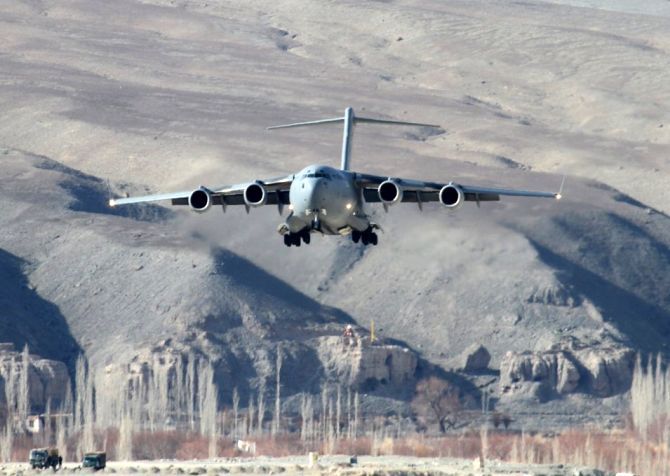 | « Back to article | Print this article |
The unstated aim of a well-publicised airlift operation of this kind is to demonstrate India's ability to rapidly move troops and equipment over long distances.
Ajai Shukla reports.
Video and Photographs: Kind courtesy Indian Air Force

Signalling the coming of age of India's strategic airlift capability, the Indian Air Force mounted an unprecedented airlift in which its transport aircraft fleet airlifted almost 500 tonnes of equipment to Ladakh in one coordinated operation on Tuesday, December 18.
It was called Exercise Bahubali.
Terming this an effort to evaluate its own rapid airlift capability, the IAF announced: 'The effort was accomplished with the aid of a fleet of 16 fixed-wing transport aircraft comprising C-17 Globemaster, the Ilyushin-76 Gajraj and the medium-lift tactical aircraft, Antonov-32. All aircraft were loaded and took off from Chandigarh airbase early in the morning. The entire wave was accomplished in little less than six hours.'
Such an airlift would be invaluable in wartime, for reinforcing a threatened sector, such as Ladakh, with troops or equipment; as well as in peacetime for flying in assistance in the event of a natural disaster -- floods, an earthquake, or a tsunami.
The unstated aim of a well-publicised airlift operation of this kind is also to demonstrate India's power-projection capability, and its ability to react to strategic developments in the Indo-Pacific region by rapidly moving troops and equipment over long distances.
"Rapid air mobility is a key component of modern warfare. This assumes greater significance in short and intense wars. This is very true in India's context, especially when related to air mobility to airfields in the Ladakh region," Air Marshal N J S Dhillon of the Western Air Command, who oversaw this airlift exercise, said.
"With a wide spectrum of military transport aircraft in its inventory, the IAF today has a credible airlift capability, which has provided succour on numerous occasions when the nation was struck with natural calamities," Air Marshal Dhillon added.

The IAF first began building its strategic airlift capability when it inducted the Ilyushin-76 in the 1980s.
In 1988, the utility of these airlifters was demonstrated when they flew Indian Army paratroopers into the Maldives to respond to an SOS from then president Maumoon Abdul Gayoom who was deposed in a coup.
However, with the Ilyushin-76s, along with the AN-32 medium transport fleet, fully occupied in airlifting personnel and supplies to support remote army deployments on the Himalayan frontier -- Ladakh alone requires 3,000 tonnes of supplies every month -- the military pushed for addition heavy airlift capability.
This was provided in 2011 with the induction of 10 C-17 Globemaster III heavy lift aircraft.

Adding to the IAF's airlift capability was the procurement of 12 C-130J Super Hercules transport aircraft -- six in 2008 and another six in 2013.
While the AN-32 and Ilyushin-76 were older, less capable aircraft, the C-130J and C-17 enhanced India's airlift capability into the strategic league.
The C-130J can land and take off from short, unprepared runways, while the C-17 can lift more than 100 troops, or over 70 tonnes of equipment in a single sortie.
Boeing, which built the C-17, says it can 'take off from a 7,600 feet (2,300 metres) airfield, carry a payload of 160,000 pounds (72.5 tonnes), fly 2,400 nautical miles (4,444 kilometres), refuel in flight and land in 3,000 feet (950 metres) on less in day or by night.'
WATCH: IAF's record airlift!
Recently, the C-17 fleet was used to fly Indian Army T-72 tanks, each weighing 42 tonnes, into new deployment areas in Ladakh.
"With today's (Tuesday's) operation, the IAF has demonstrated its capability to help the army react to operational contingencies -- redeployment of troops, reinforcement of positions -= at very short notice. For a rising power like India, strategic airlift is an important capability its military must have," said Air Vice Marshal Nirdosh Tyagi (retd).